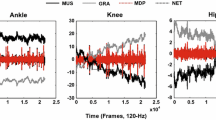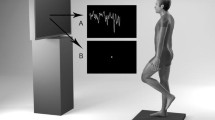Abstract
This study aimed to apply an uncontrolled manifold (UCM) approach to investigate how children utilize the variability of multiple body segment movement to facilitate the center of mass (COM) control during quiet stance. Three groups of participants were included in this study: younger children (YC, mean age 6.3 years), older children (OC, mean age 10.3 years), and young adults (YA, mean age 20.5 years). Participants stood on a force platform with their hands on the iliac crests for 40 s in each trial. Two visual conditions were examined including eyes-open and eyes-closed and three trials were collected for each condition. Results showed that all three groups partitioned more variability of multi-segment movement into the UCM subspace (maintaining the mean COM position) than into the ORT subspace (a subspace orthogonal to the UCM subspace, causing the deviation of the COM from its mean position) in both eyes-open and eyes-closed conditions. Furthermore, both the YC and OC groups partitioned a significantly higher percentage of variability into the UCM subspace than the YA group regardless of visual condition. In addition, results of conventional COM variables indicated that only the YC group produced significantly faster sway velocity and greater standard deviation than the YA group. All the results together suggest that children at 6–10 years of age use a similar variability-partitioning strategy (a greater V UCM and a smaller V ORT) like young adults in quiet stance to facilitate the COM control, but it takes more than 10 years for children to refine this strategy and achieve an adult-like variability-partitioning capability (i.e., UCM ratio). It also suggests that postural development may include two phases in which children learn to regulate the position and movement of multiple body segments and the COM first and gain an adult-like variability-partitioning capability later.





Similar content being viewed by others
References
Alexandrov AV, Frolov AA, Horak FB, Carlson-Kuhta P, Park S (2005) Feedback equilibrium control during human standing. Biol Cybern 93:309–322
Assaiante C, Amblard B (1993) Ontogenesis of head stabilization in space during locomotion in children: influence of visual cues. Exp Brain Res 93:499–515
Bernstein N (1967) The coordination and regulation of movements. Pergamon Press, Oxford
Black D, Smith B, Wu J, Ulrich B (2007) Uncontrolled manifold analysis of segmental angle variability during walking: preadolescents with and without Down syndrome. Exp Brain Res 183:511–521
Figura F, Cama G, Capranica L, Guidetti L, Pulejo C (1991) Assessment of static balance in children. J Sports Med Phys Fitness 31:235–242
Forssberg H, Nashner LM (1982) Ontogenetic development of postural control in man: adaptation to altered support and visual conditions during stance. J Neurosci 2:545–552
Horak FB, Nashner LM (1986) Central programming of postural movements: adaptation to altered support-surface configurations. J Neurophysiol 55:1369–1381
Horak FB, Nashner LM, Diener HC (1990) Postural strategies associated with somatosensory and vestibular loss. Exp Brain Res 82:167–177
Hsu W-L, Scholz JP, Schoner G, Jeka JJ, Kiemel T (2007) Control and estimation of posture during quiet stance depends on multijoint coordination. J Neurophysiol 97:3024–3035
Jensen RK (1986) Body segment mass, radius and radius of gyration proportions of children. J Biomech 19:359–368
Kirshenbaum, Kirshenbaum N, Riach, Riach C, Starkes, Starkes J (2001) Nonlinear development of postural control and strategy use in young children: a longitudinal study. Exp Brain Res 140:420–431
Krishnamoorthy V, Yang J-F, Scholz JP (2005) Joint coordination during quiet stance: effects of vision. Exp Brain Res 164:1–17
Latash M, Krishnamoorthy V, Scholz J, Zatsiorsky V (2005) Postural synergies and their development. Neural Plas 12:119–130
Lee DN, Aronson E (1974) Visual proprioceptive control of standing in human infants. Percept Psychophys 15:529–532
Massion J (1992) Movement, posture and equilibrium: interaction and coordination. Prog Neurobiol 38:35–56
Nougier V, Bard C, Fleury M, Teasdale N (1998) Contribution of central and peripheral vision to the regulation of stance: developmental aspects. J Exp Child Psychol 68:202–215
Peterka RJ (2002) Sensorimotor integration in human postural control. J Neurophysiol 88:1097–1118
Pinter IJ, van Swigchem R, van Soest AJK, Rozendaal LA (2008) The dynamics of postural sway cannot be captured using a one-segment inverted pendulum model: A PCA on segment rotations during unperturbed stance. J Neurophysiol 100:3197–3208
Prieto TE, Myklebust JB, Hoffmann RG, Lovett EG, Myklebust BM (1996) Measures of postural steadiness: differences between healthy young and elderly adults. IEEE Trans Biomed Eng 43:956–966
Riach CL, Starkes JL (1989) Visual fixation and postural sway in children. J Mot Behav 21:265–276
Riach CL, Starkes JL (1994) Velocity of center of pressure excursions as an indicator of postural control systems in children. Gait Posture 2:167–172
Rival C, Ceyte H, Olivier I (2005) Developmental changes of static standing balance in children. Neurosci Lett 376:133–136
Schmid M, Conforto S, Lopez L, Renzi P, D’Alessio T (2005) The development of postural strategies in children: a factorial design study. J NeuroEng Rehabil 2:29
Scholz JP, Schöner G (1999) The uncontrolled manifold concept: identifying control variables for a functional task. Exp Brain Res 126:289–306
Scholz J, Reisman D, Schöner G (2001) Effects of varying task constraints on solutions to joint coordination in a sit-to-stand task. Exp Brain Res 141:485–500
Scholz J, Schöner G, Hsu W, Jeka J, Horak F, Martin V (2007) Motor equivalent control of the center of mass in response to support surface perturbations. Exp Brain Res 180:163–179
Schöner G (1995) Recent developments and problems in human movement science and their conceptual implications. Ecol Psychol 7:291–314
Shumway-Cook A, Woollacott MH (1985) The growth of stability: postural control from a developmental perspective. J Mot Behav 17:131–147
Smith BA, Kubo M, Black DP, Holt KG, Ulrich BD (2007) Effect of practice on a novel task—walking on a Treadmill: preadolescents with and without Down syndrome. Phys Ther 87:766–777
Sveistrup H, Woollacott MH (1996) Longitudinal development of the automatic postural response in infants. J Mot Behav 28:58–70
Ulrich BD, Haehl V, Buzzi UH, Kubo M, Holt KG (2004) Modeling dynamic resource utilization in populations with unique constraints: preadolescents with and without Down syndrome. Hum Mov Sci 23:133–146
Winter DA (1990) Biomechanics and motor control of human movement. Wiley, New York
Winter DA, Patla AE, Prince F, Ishac M, Gielo-Perczak K (1998) Stiffness control of balance in quiet standing. J Neurophysiol 80:1211–1221
Woollacott MH, Debu B, Mowatt M (1987) Neuromuscular control of posture in the infant and child: is vision dominant? J Mot Behav 19:167–186
Acknowledgments
We would like to thank all the participants and the parents to take part in this study. Thanks are also due to the undergraduate students at the University of Michigan who helped collect and analyze data.
Author information
Authors and Affiliations
Corresponding author
Rights and permissions
About this article
Cite this article
Wu, J., McKay, S. & Angulo-Barroso, R. Center of mass control and multi-segment coordination in children during quiet stance. Exp Brain Res 196, 329–339 (2009). https://doi.org/10.1007/s00221-009-1852-z
Received:
Accepted:
Published:
Issue Date:
DOI: https://doi.org/10.1007/s00221-009-1852-z




